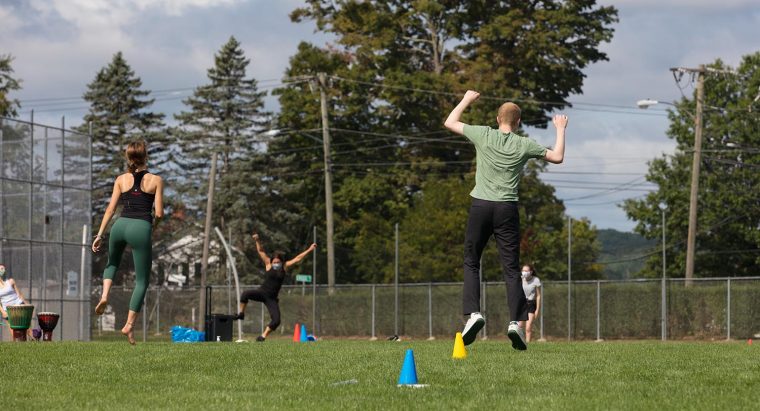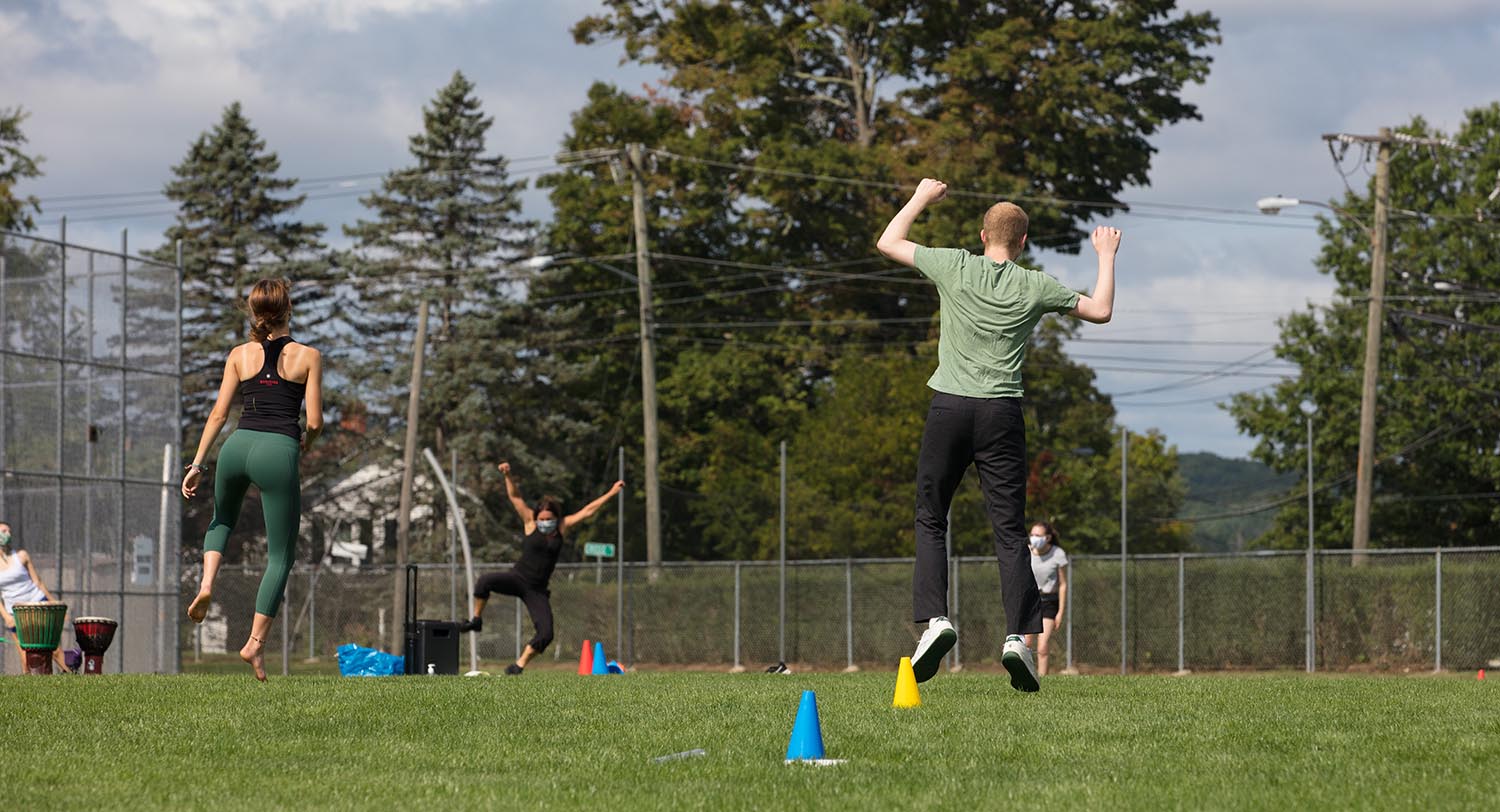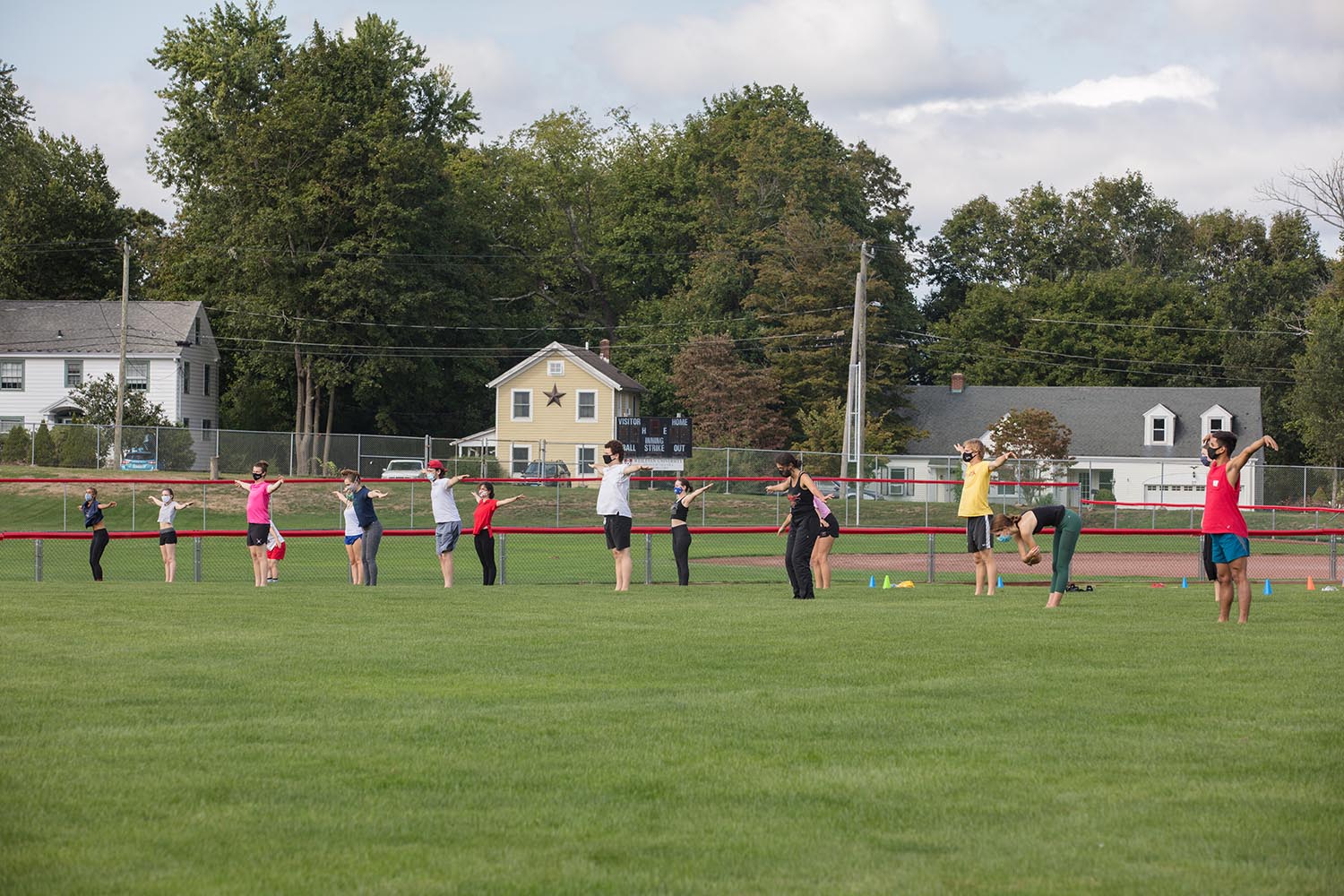Students Explore New Reality through Dance

When the COVID-19 outbreak disrupted in-person classes last spring, several faculty found innovative and creative ways to adapt to online teaching and learning.
In the third of a fall-semester series, we’ll be highlighting ways faculty from various departments are coping with teaching during a pandemic, and showcase individual ways courses are thriving in an in-person, online, or hybridized environment.
In this issue, we spotlight Katja Kolcio, associate professor of dance and director of the Allbritton Center. Kolcio also is a core faculty member of the College of the Environment, Environmental Studies, and Russian, East European and Eurasian Studies Programs at Wesleyan. This fall, she’s teaching DANC 216: Contemporary Dance Technique: Dancing During Pandemic; DANC 435: Advanced Dance Practice A; and DANC 445: Advanced Dance Practice B.


In a standard Wesleyan dance technique course, students corral inside a studio setting and work to develop artistic virtuosity in a particular dance genre: ballet, contemporary, hip-hop, jazz, West African, South Indian, and Afro-Brazilian.
But when the pandemic and its effects fundamentally altered the way people interact, communicate, and engage with one another, Katja Kolcio, associate professor of dance, decided to design a course specifically focusing on bringing attention to the physical experience of our new reality. So she created the practice-based course DANC 216: Dancing During Pandemic, open to all students.
“It’s common to feel too busy to dedicate attention to our physical sensations and experiences, or to the way in which new ideas or realities encountered in the world resonate within us,” Kolcio said. “So with this course, we examine, ‘How do we physically and socially navigate the new environment?’ We need to fully engage in our physical selves and awareness and bring greater attention to the ways humans utilize our physical and creative capacities.”
Kolcio teaches a combination of somatic mind-body practices and creative physical exploration while investigating and navigating new social, political, and environmental contexts. Although the content of the course is existential, students learn to find the work to be practical and applicable, “from getting out of bed in the morning, embarking on new projects, connecting with people and communities, building careers, to enacting change in the world,” Kolcio said.
The 25 students gather Friday mornings near the Wesleyan softball fields. Along with Kolcio; musician Joseph Getter MA ’99; and course assistant Halle Newman ’23, the classmates stand in a circle, 12 feet apart, allowing for social distancing and a margin for movement. When spread linearly, the class spans approximately 180 feet, or half the length of a football field.
“I lost my voice in the first half-hour of class, and we quickly realized how much is communicated without words,” Kolcio said. “This is all part of the learning—the investigation. We are all in it together.”
The act of simply being outside the studio plays a crucial role in the new class by supporting the three basic elements of movement: time, space, and energy. Visual fields extend below the floor, ceiling, and walls of a room.
“Looking up into the infinite sky changes our frame of reference and experience of what it means to be positioned as a human in the present moment,” Kolcio said. “Our ability to comprehend scale and size is impacted by the vividness of our relationship to the earth (very big round thing stuck to the soles of our feet). The range of timing/duration expands to encompass the pace of grass growing (very slow), and the speed of sound traveling from great distances. There are no walls to contain and concentrate our energy, so how can we focus ourselves? These questions become very specific and practical, and this offers us a new lens through which to think and make choices.”
Kolcio based the Dancing During Pandemic course syllabus on her work in the war relief effort in Ukraine. She’s been invited to Ukraine each year since the 2014 Ukrainian Revolution of Dignity to lead workshops in somatic resilience to help participants generate resilience and creative agency during trauma, crisis, and social change. The work is only indirectly about ‘stress relief;’ it’s actually about maintaining sensitivity to the present moment, and to our humanity.
This month, she was awarded a $62,000 grant to expand her project in Ukraine as part of the United Nation’s efforts in “strengthening national and local capacities for effective delivery of security, justice and reintegration services in conflicted areas of Ukraine.”
“Dancing During Pandemic is at the heart of why I entered the field of dance in the first place,” she said. “I consider myself a political activist—but I realized early on that the most significant social change, for better or worse, happens at the level of our physical selves. This premise is incorporated into every class I teach—my activism takes shape in my classes.”
While the focus of the class is to investigate and navigate new social, political, and environmental contexts, Kolcio hopes the course’s biggest takeaway is that “you can always reorient, actively navigate, and invent new ‘modes of operation’ to find better, healthier, more just ways of being and interacting,” she said. “In fact, this is the only way substantive social change is possible—by finding new ways to be, and be with one another, in the world.”

